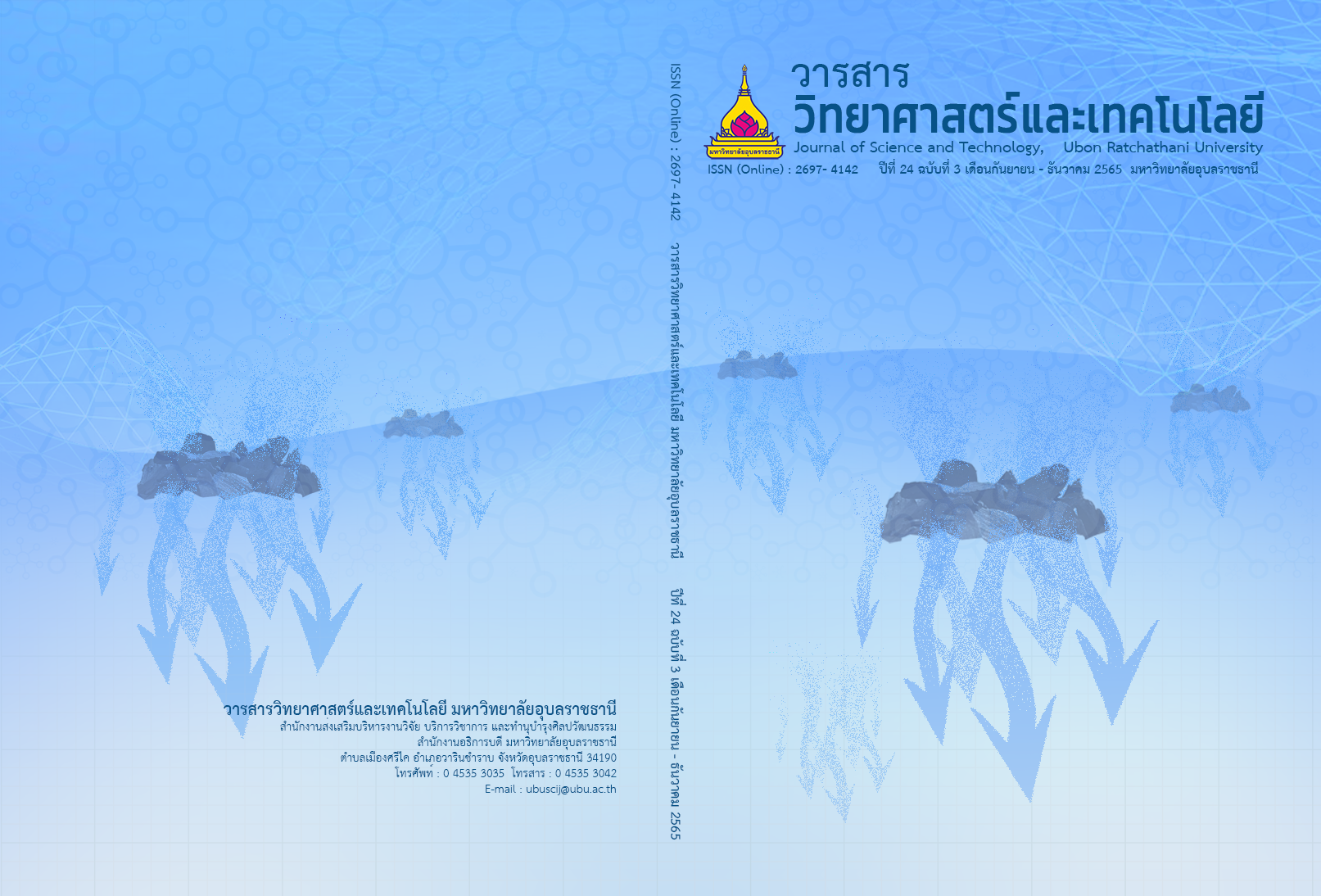การดูดซับแมงกานีสจากน้ำใต้ดินด้วยถ่านชีวภาพยูคาลิปตัส
Main Article Content
บทคัดย่อ
แมงกานีสมักตรวจพบในน้ำใต้ดิน และการดูดซับเป็นวิธีที่นิยมใช้ในการกำจัดแมงกานีส งานวิจัยนี้มีวัตถุประสงค์เพื่อใช้ถ่านชีวภาพยูคาลิปตัสเพื่อดูดซับแมงกานีสจากน้ำใต้ดิน และศึกษาการตรึงโลหะหนักแมงกานีสในถ่านชีวภาพ โดยใช้ถ่านชีวภาพ 1 กรัม ดูดซับน้ำบาดาลที่มีแมงกานีสความเข้มข้น 1.098 มิลลิกรัมต่อลิตร วัดความเข้มข้นของแมงกานีสที่เหลือที่ระยะเวลาต่าง ๆ จนถึงระยะเวลาสมดุล ศึกษาจลนพลศาสตร์ของการดูดซับโดยใช้สมการปฏิกิริยาอันดับหนึ่งเทียมและปฏิกิริยาอันดับสองเทียม นำถ่านชีวภาพที่ดูดซับแมงกานีสแล้วไปสกัดตามลำดับเพื่อหาสัดส่วนรูปของแมงกานีสที่ถูกตรึงในถ่านชีวภาพ เปรียบเทียบกับถ่านชีวภาพที่ยังไม่ได้ใช้ดูดซับ ผลการศึกษาพบว่าถ่านชีวภาพมีความสามารถในการดูดซับแมงกานีสเท่ากับ 0.0146 มิลลิกรัมต่อกรัม ที่ระยะเวลาสมดุล 48 ชั่วโมง และการดูดซับเป็นไปตามปฏิกิริยาอันดับสองเทียม ผลการสกัดตามลำดับพบว่าแมงกานีสถูกตรึงกับส่วนของเหล็กและแมงกานีสออกไซด์สูงที่สุดเป็นสัดส่วนร้อยละ 23.89 ตามด้วยการตรึงในส่วนของสารอินทรีย์ร้อยละ 23.88
Article Details

อนุญาตภายใต้เงื่อนไข Creative Commons Attribution-NonCommercial-NoDerivatives 4.0 International License.
บทความที่ได้รับการตีพิมพ์เป็นลิขสิทธิ์ของ วารสารวิทยาศาสตร์และเทคโนโลยี มหาวิทยาลัยอุบลราชธานี
ข้อความที่ปรากฏในบทความแต่ละเรื่องในวารสารวิชาการเล่มนี้เป็นความคิดเห็นส่วนตัวของผู้เขียนแต่ละท่านไม่เกี่ยวข้องกับมหาวิทยาลัยอุบลราชธานี และคณาจารย์ท่านอื่นๆในมหาวิทยาลัยฯ แต่อย่างใด ความรับผิดชอบองค์ประกอบทั้งหมดของบทความแต่ละเรื่องเป็นของผู้เขียนแต่ละท่าน หากมีความผิดพลาดใดๆ ผู้เขียนแต่ละท่านจะรับผิดชอบบทความของตนเองแต่ผู้เดียว
เอกสารอ้างอิง
Schneider, J.S. and et al. 2013. Chronic manganese exposure impairs visuospatial associative learning in non-human primates. Toxicology letters. 221(2): 146-151.
Idrees, M. and et al. 2018. Adsorption and thermodynamic mechanisms of manganese removal from aqueous media by biowaste-derived biochars. Journal of Molecular Liquids. 266: 373-380.
Venkatesan, G., Senthilnathan, U. and Rajam, S. 2014. Cadmium removal from aqueous solutions using hybrid eucalyptus wood based activated carbon: Adsorption batch studies. Clean Technologies and Environmental Policy. 16(1): 195-200.
Singh, B., Walia, B.S. and Arora, R. 2018. Eucalyptus wood charcoal as Biosorbent for removal of lead (II) ions from aqueous solution. International Journal of Research and Analytical Reviews. 5(4): 933-938.
Anastopoulos, I., Ahmed, M.J. and Hummadi, E.H. 2022. Eucalyptus-based materials as adsorbents for heavy metals and dyes removal from (waste)waters. Journal of Molecular Liquids. 356: 118864.
Lalhruaitluanga, H. and et al. 2010. Lead (II) adsorption from aqueous solutions by raw and activated charcoals of Melocanna baccifera Roxburgh (bamboo) - A comparative study. Journal of Hazardous Materials. 175(1-3): 311-318.
Wang, A. and et al. 2021. Speciation and environmental risk of heavy metals in biochars produced by pyrolysis of chicken manure and water-washed swine manure. Scientific Reports. 11(1): 1-14.
Mancinelli, E. and et al. 2016. Trace metals in biochars from biodegradable by-products of industrial processes. Water, Air & Soil Pollution. 227(6): 1-21.
Zhou, Z.F. 2015. Content of heavy metals in BioChars and assessment of ecological risk on their application to soil. In: Proceedings of the International Conference on Energy, Environmental & Sustainable Ecosystem Development, 21-23 August 2015. Kunming, China.
Zhou, D. and et al. 2017. Effects of biochar-derived sewage sludge on heavy metal adsorption and immobilization in soils. International Journal of Environmental Research and Public Health. 14(7): 681.
Bandara, T. and et al. 2017. Efficacy of woody biomass and biochar for alleviating heavy metal bioavailability in serpentine soil. Environmental Geochemistry and Health. 39(2): 391-401.
Cui, L. and et al. 2015. Does biochar alter the speciation of Cd and Pb in aqueous solution. Bioresources. 10(1): 88-104.
Saha, S., Reza, A.S. and Roy, M.K. 2019. Hydrochemical evaluation of groundwater quality of the Tista floodplain, Rangpur Bangladesh. Applied Water Science. 9: 198.
Burnette, R. 2016. Charcoal Production in 200-Liter Horizontal Drum Kilns. https://www.echo community.org/resources/069529b4-0ce4-475c-99b8-326957e3afa7. Accessed 1 July 2022.
Tippayawong, N. and et al. 2010. Production of charcoal from woods and bamboo in a small natural draft carbonizer. International Journal of Energy Environmental. 1(5): 911-918.
Ho, Y.S. and McKay, G. 1998. Kinetic models for the sorption of dye from aqueous solution by wood. Process Safety and Environmental Protection. 76(2): 183-191.
Mckay, G. and Poots, V.J. 1980. Kinetics and diffusion processes in colour removal from effluent using wood as an adsorbent. Journal of Chemical Technology & Biotechnology. 30: 279-292.
Tessier, A.P.G.C., Campbell, P.G. and Bisson, M.J.A.C. 1979. Sequential extraction procedure for the speciation of particulate trace metals. Analytical Chemistry. 51(7): 844-851.
Mukherjee, A., Zimmerman, A.R. and Harris, W. 2011. Surface chemistry variations among a series of laboratory-produced biochars. Geoderma. 163: 247-255.
Khawkomol, S. and et al. 2021. Potential of biochar derived from agricultural residues for sustainable management. Sustainability. 13(15): 814.
Kumar, S. and et al. 2011. An assessment of U (VI) removal from groundwater using biochar produced from hydrothermal carbonization. Journal of Environmental Management. 92(10): 2504-2512.
Jiang, B., Lin, Y. and Mbog, J.C. 2018. Biochar derived from swine manure digestate and applied on the removals of heavy metals and antibiotics. Bioresource Technology. 270: 603-611.
Koseoglu, E. and Akmil-Basar, C. 2015. Preparation, structural evaluation and adsorptive properties of activated carbon from agricultural waste biomass. Advanced Powder Technology. 26(3): 811-818.
Ding, Y. and et al. 2020. Mesoporous MnO 2/SBA-15 as a synergetic adsorbent for enhanced uranium adsorption. New Journal of Chemistry. 44(32): 13707-13715.
Yang, C. and et al. 2020. The preparation of a novel iron/manganese binary oxide for the efficient removal of hexavalent chromium [Cr (vi)] from aqueous solutions. RSC Advances. 10(18): 10612-10623.
Mohair, D. and Pittman, C.U. 2007. Arsenic removal from water/wastewater using adsorbents - A critical review. Journal of Hazardous Materials. 142(1-2): 1-53.
Ho, Y.S. and McKay, G. 1999. Pseudo-second order model for sorption processes. Process Biochemistry. 34(5): 451-465.
Dawodu, F.A. and Akpomie, K.G. 2014. Simultaneous adsorption of Ni(II) and Mn(II) ions from aqueous solution unto a Nigerian kaolinite clay. Journal of Materials Research and Technology. 3(2): 129-141.
Nkinahamira, F. and et al. 2019. Occurrence, geochemical fractionation, and environmental risk assessment of major and trace elements in sewage sludge. Journal of Environmental Management. 249: 109427.


